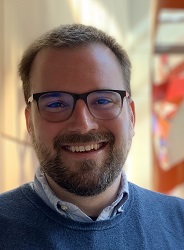Quantitative Virology and Evolution Unit
Patrick T. Dolan, Ph.D.
Unit Chief, Quantitative Virology and Evolution Unit
Earl Stadtman Tenure-Track Investigator

Major Areas of Research
- Virus-host dynamics at single-cell resolution
- Virus evolution within and across hosts
- Systems biology of virus infection
- RNA Viruses: Picornaviridae, Flaviviridae, and others
Program Description
The Quantitative Virology and Evolution Unit focuses on understanding the dynamic and heterogenous processes of RNA virus infection and evolution. Using experimental tools, including high-resolution sequencing and live-cell microscopy, along with computational phylogenetic and bioinformatic tools, we characterize virus evolution and host-virus interactions across spatial and temporal scales. Projects in the lab include single-cell and single-genome sequencing of within-host virus evolution and host responses, phylogenetic reconstruction and evolutionary biochemistry in emerging RNA viruses, and design and analysis of mutational and functional genetic screens.
Biography
Education
Ph.D., 2014, Virology/Computational Systems Biology, Purdue University, West Lafayette, IN
B.S., 2007, Microbiology and Molecular Genetics, Michigan State University, East Lansing, MI
Patrick T. Dolan, Ph.D., is an experimental virologist and computational biologist whose work focuses primarily on the evolution and host-virus interactions of positive-sense RNA viruses. In the fall of 2021, Patrick began as unit chief of the Quantitative Virology and Evolution Unit at NIAID in Bethesda, MD, where he will continue to study the forces that shape the long- and short-term evolution of RNA virus populations.
Patrick earned his B.S. degree in microbiology and molecular genetics from Michigan State University, where he worked in the laboratory of professor Yong-Hui Zheng on the antiviral function of APOBEC3 cytidine deaminases in HIV-1. Patrick earned his Ph.D. in biological sciences in 2014 from Purdue University, where he studied the form and function of the hepatitis C virus-host protein interaction network under the supervision of professor Douglas J. LaCount and co-advisor professor Michael Gribskov. Patrick then pursued postdoctoral studies at Stanford University and University of California, San Francisco, in the laboratories of professors Raul Andino and Judith Frydman where he developed methods to understand the evolutionary dynamics of enteroviruses and flaviviruses in alternative host environments.
Selected Publications
Dábilla N, Dolan PT. Structure and dynamics of enterovirus genotype networks. Sci Adv. 2024 Jun 21;10(25):eado1693.
Bakhache W, Symonds-Orr W, McCormick L, Dolan PT. Deep mutation, insertion and deletion scanning across the Enterovirus A proteome reveals constraints shaping viral evolution. Nat Microbiol. 2025 Jan;10(1):158-168.
Bakhache W, Shen A, Symonds-Orr W, Freeman MC, Dolan PT. Novel reporter constructs to accelerate antiviral and therapeutic discovery for Enterovirus-A71. Antiviral Res. 2025 Feb 1;235:106094.
Dolan PT, Taguwa S, Rangel MA, Acevedo A, Hagai T, Andino R, Frydman J. Principles of dengue virus evolvability derived from genotype-fitness maps in human and mosquito cells. Elife. 2021 Jan;10:e61921.
Dolan PT, Whitfield ZJ, Andino R. Mapping the Evolutionary Potential of RNA Viruses. Cell Host Microbe. 2018 Apr;23(4):435-446.
Xiao Y, Dolan PT, Goldstein EF, Li M, Farkov M, Brodsky L, Andino R. Poliovirus intrahost evolution is required to overcome tissue-specific innate immune responses. Nat Commun. 2017 Aug;8(1):375.
Research Group
The Quantitative Virology and Evolution Unit focuses on understanding the dynamic and heterogenous processes of RNA virus infection and evolution. We characterize virus evolution and host-virus interactions across spatial and temporal scales using experimental tools, including high-resolution sequencing and live-cell microscopy, along with computational phylogenetic and bioinformatic tools…

